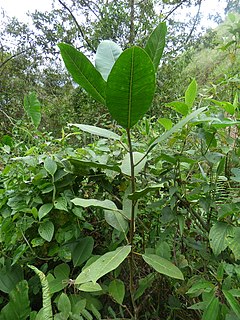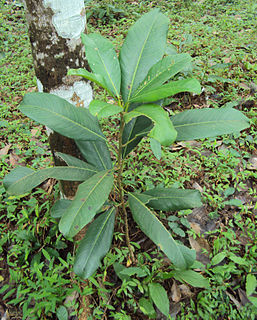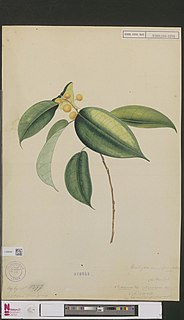
Ficus is a genus of about 850 species of woody trees, shrubs, vines, epiphytes and hemiepiphytes in the family Moraceae. Collectively known as fig trees or figs, they are native throughout the tropics with a few species extending into the semi-warm temperate zone. The common fig (F. carica) is a temperate species native to southwest Asia and the Mediterranean region, which has been widely cultivated from ancient times for its fruit, also referred to as figs. The fruit of most other species are also edible though they are usually of only local economic importance or eaten as bushfood. However, they are extremely important food resources for wildlife. Figs are also of considerable cultural importance throughout the tropics, both as objects of worship and for their many practical uses.

The Moraceae — often called the mulberry family or fig family — are a family of flowering plants comprising about 38 genera and over 1100 species. Most are widespread in tropical and subtropical regions, less so in temperate climates; however, their distribution is cosmopolitan overall. The only synapomorphy within the Moraceae is presence of laticifers and milky sap in all parenchymatous tissues, but generally useful field characters include two carpels sometimes with one reduced, compound inconspicuous flowers, and compound fruits. The family includes well-known plants such as the fig, banyan, breadfruit, mulberry, and Osage orange. The 'flowers' of Moraceae are often pseudanthia.

Ficus macrophylla, commonly known as the Moreton Bay fig or Australian banyan, is a large evergreen banyan tree of the family Moraceae native to eastern Australia, from the Wide Bay–Burnett region in the north to the Illawarra in New South Wales, as well as Lord Howe Island. Its common name is derived from Moreton Bay in Queensland, Australia. It is best known for its imposing buttress roots.

Ficus microcarpa, also known as Chinese banyan, Malayan banyan, Indian laurel, curtain fig, or gajumaru (ガジュマル), is a tree in the fig family Moraceae. It is native in a range from China through tropical Asia and the Caroline Islands to Australia. It is widely planted as a shade tree and frequently misidentified as F. retusa or as F. nitida.

Ficus aurea, commonly known as the Florida strangler fig, golden fig, or higuerón, is a tree in the family Moraceae that is native to the U.S. state of Florida, the northern and western Caribbean, southern Mexico and Central America south to Panama. The specific epithet aurea was applied by English botanist Thomas Nuttall who described the species in 1846.
Ficus maxima is a fig tree which is native to Mexico, Central America, the Caribbean and South America south to Paraguay. Figs belong to the family Moraceae. The specific epithet maxima was coined by Scottish botanist Philip Miller in 1768; Miller's name was applied to this species in the Flora of Jamaica, but it was later determined that Miller's description was actually of the species now known as Ficus aurea. To avoid confusion, Cornelis Berg proposed that the name should be conserved for this species. Berg's proposal was accepted in 2005.

Pharmacosycea is one of six subgenera currently recognised in the genus Ficus. It was proposed by E. J. H. Corner in 1967 to unite section Pharmacosycea with Oreosycea.

Ficus americana, commonly known as the West Indian laurel fig or Jamaican cherry fig, is a tree in the family Moraceae which is native to the Caribbean, Mexico in the north, through Central and South America south to southern Brazil. It is an introduced species in Florida, USA. The species is variable; the five recognised subspecies were previously placed in a large number of other species.

Ficus platypoda, commonly known as the desert fig or rock fig, is a fig that is endemic to central and northern Australia. It is a lithophytic plant that grows on rocky outcrops, reaching 10 m in height.

Ficus obliqua, commonly known as the small-leaved fig, is a tree in the family Moraceae, native to eastern Australia, New Guinea, eastern Indonesia to Sulawesi and islands in the southwestern Pacific Ocean. Previously known for many years as Ficus eugenioides, it is a banyan of the genus Ficus, which contains around 750 species worldwide in warm climates, including the edible fig. Beginning life as a seedling, which grows on other plants (epiphyte) or on rocks (lithophyte), F. obliqua can grow to 60 m (200 ft) high and nearly as wide with a pale grey buttressed trunk, and glossy green leaves.

The Castilleae are a tribe within the plant family Moraceae. It includes eight to 11 genera and 55–60 species including Castilla, the Panama rubber tree.

Dorstenia elata is a plant species in the family Moraceae.

Ficus subpisocarpa is a species of small deciduous tree native to Japan, China, Taiwan and southeast Asia to the Moluccas (Ceram). Two subspecies are recognised. Terrestrial or hemiepiphytic, it reaches a height of 7 m (23 ft). Ants predominantly of the genus Crematogaster have been recorded living in stem cavities. Ficus subpisocarpa is pollinated by Platyscapa ishiiana (Agaonidae).

Ficus altissima, commonly known as the council tree and lofty fig, is a species of flowering plant, a fig tree in the family Moraceae. It is a large, stately evergreen hemiepiphyte and is native to southeastern Asia.

Ficus exasperata, also called the sandpaper tree, forest sandpaper fig, white fig, or sandpaper leaf tree, is a deciduous, and dioecious species of plant in the mulberry family Moraceae, native to tropical Africa and southern Asia.

Ficus glaberrima is an Asian species of fig tree in the family Moraceae. The native range of this species is India, S. China and tropical Asia: Indo-China to the Lesser Sunda Islands. The species can be found in Vietnam: where it may be called đa trụi or đa lá xanh.

Ficus kurzii may be called the Burmese banyan: it is an Asian species of fig tree in the family Moraceae. No subspecies are listed in the Catalogue of Life; its native range is China (Yunnan) Indo-China and Malesia. The species can be found in Vietnam: where it may be called Ða Kurz.

Ficus callosa is an Asian species of fig tree in the family Moraceae. No subspecies are listed in the Catalogue of Life; the native range of this species is India, southern China, Indo-China and Malesia. The species can be found in Vietnam: where it may be called đa chai or đa gùa.

Ficus rumphii is a banyan fig species in the family Moraceae. No subspecies are listed in the Catalogue of Life. The species can be found in: India, southern China, Indo-China and Malesia. In Vietnam it may be called lâm vồ or đa mít.

Ficus depressa is a banyan fig species in the family Moraceae. No subspecies are listed in the Catalogue of Life. The species can be found in Indo-China and Malesia. In Vietnam it may be called sung xoài or đa nước.

















